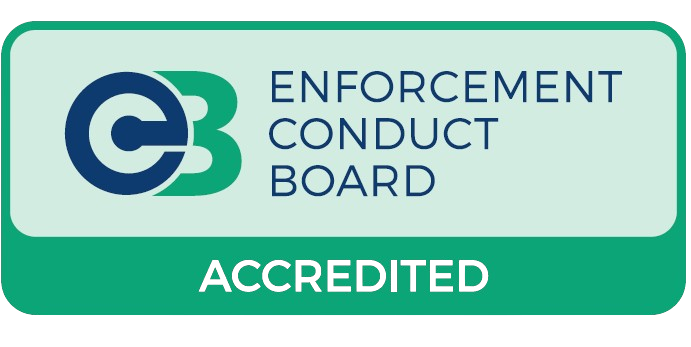How to Recover Commercial Rent Arrears in Manchester?
Our Certificated Enforcement Agents (Bailiffs) will attend your rental property in Manchester and collect your commercial tenants outstanding rent arrears - usually at no cost to the landlord*
Commercial Rent Arrears Recovery is regulated under Section 72 of the Tribunal Courts and Enforcement Act 2007 and the Taking Control of Goods Regulations 2014
Commercial Rent Arrears Recovery (CRAR) is a method of enforcement to recover rent arrears relating to commercial properties.
CRAR came into force on 6th April 2014 when the common law right of distress was abolished and replaced by the Tribunals Courts and Enforcement Act (TCEA) and the Taking Control of Goods Regulations (TCG)
CRAR allows the landlord to instruct an enforcement agent (bailiff) to take control of the tenants’ goods and if necessary, sell them in order to recover an equivalent value to the rent arrears. It also requires legal notices to be served on the tenant by the enforcement agent
Legislation exists under the Taking Control of Goods Regulations 2013 to allow a landlord of a commercial property to instruct bailiffs (enforcement agents) to collect rent arrears without the need to go to Court.
The powers under these regulations are identical to those powers Enforcement Agents have in collecting Council Tax and Business Rates.
The Enforcement agents who attend under CRAR are legally allowed to remove your tenants goods under this legislation.
The cost to the landlord is usually zero. All enforcement fees are passed on to the tenant.
The process is explained below, but if you have any questions prior to instructing us, please get in touch.
Stage 1: Instruct us Online
- You instruct us online HERE
- Once we have received the forms, we will check details and generate a Warrant of Control. This allows us to legally collect your debt.
- We will email you a copy and await approval to proceed.
- We will then send you a secure link to our Case Management System where you will be able to see all case updates.
Stage 2: Compliance Stage
As soon as we have received your instructions and approval, we will send out a Notice of Enforcement to your tenant - You can see an example HERE
- This is a legal requirement, and we have to give your tenant 7 clear days in which to respond.
- If your tenant has not paid the outstanding debt including our fees by the end of this period, we will contact you to authorise Stage 3
Stage 3: Enforcement Stage
- A Certificated Enforcement Agent (Bailiff) will attend your tenants demise premises and look at recovering full payment or taking control of their goods.
- If the business is closed at the time of visit, we will schedule up to 3 more visits including out of hours.
- If the tenant is unwilling/ unable to pay, we will look at removing goods to pay for the debt. We will consult with you if it reaches this point.
Stage 4: Case Conclusion
- If we have been successful in recovering full payment and our fees, we will send you a report and payment within 48 hours of us receiving cleared funds.
- If we have secured a payment arrangement with your tenant we will continue to monitor payments until the debt and fees are recovered.
- If we have been unsuccessful, we will contact you to discuss further options.
Commercial Rent Arrears Recovery (CRAR) is a method of enforcement to recover rent arrears relating to commercial properties.
CRAR came into force on 6th April 2014 when the common law right of distress was abolished and replaced by the Tribunals Courts and Enforcement Act (TCEA) and the Taking Control of Goods Regulations (TCG).
CRAR allows the landlord to instruct an enforcement agent (bailiff) to take control of the tenants’ goods and if necessary, sell them in order to recover an equivalent value to the rent arrears. It also requires legal notices to be served on the tenant by the enforcement agent
Who is the Landlord?
The TCEA defines the landlord as “ the person for the time being entitled to the immediate reversion in the property comprised in the lease.”. Therefore it can be exercised by a landlord whose immediate tenant has failed to pay the rent.
To which Leases does CRAR apply?
CRAR applies to all tenancies of commercial premises, whether the tenancy is legal or equitable (including tenancies at will). The tenancy must be in writing for CRAR to apply. If the tenancy is unwritten, CRAR cannot be exercised.
CRAR does not apply to licences to occupy or tenancy at sufferance.
A tenancy at sufferance arises when a tenant remains in occupation after its lease has expired, but the landlord has not confirmed that it is willing for the tenant to remain.
CRAR only applies to tenancies and therefore will not be available to a licensor for non-payment of a licence fee.
It is important to be aware that using CRAR will waive any right to forfeit that may have arisen in that rental period.
Mixed Use Premises
CRAR will only apply to the lease if the premises are let and used for commercial purposes.
However, a lease will still be within the scope of CRAR if the residential occupation is in breach of the terms of the lease or any superior lease. These provisions are designed to stop a commercial tenant avoiding CRAR by allowing a third party to occupy part of the premises as a dwelling in breach of the lease.
What rent can be recovered under CRAR?
For the purposes of CRAR “rent” is the amount payable under the lease for the possession and use of the premises (together with any interest and VAT chargeable).
Rent does not include any rates, , services, repairs, maintenance or insurance even if these amounts are reserved as rent in the lease.
Where the lease provides for an inclusive rent (one that includes elements relating to other expenses, such as business rates or utilities), only the proportion that is reasonably attributable to the possession and use of the premises is recoverable under CRAR.
Conditions to be satisfied before CRAR can be exercised
The following conditions must be satisfied before CRAR can be exercised:-
- The tenant must be in arrears of rent before the Notice of Enforcement is given;
- The amount of the arrears must be certain or capable of being calculated with certainty;
- The “net unpaid rent “equals or exceeds a minimum amount equal to 7 days rent;
- The tenant must be in arrears of the net unpaid rent when goods are taken into control.
- 7 clear days notice must be given by the enforcement agent.
Authorisation by landlord to exercise CRAR
Where a landlord gives authorisation under section 73(8) of the Act to an enforcement agency (bailiff) to exercise CRAR on the landlord’s behalf, the authorisation must
- only authorise an enforcement agency or agent,
- be in writing, be signed by the landlord and provide the following information:
- the date of authorisation;
- the landlord’s name and contact details;
- the name and contact details of the person authorised to act on behalf of the landlord;
- have sufficient detail to enable the authorised person to identify the commercial premises in respect of which CRAR may now be exercised on the landlord’s behalf
- the amount of rent owed; and
- the period in relation to which the rent is owed.
Using CRAR when a Lease has ended
CRAR only applies if control of the goods was taken before the lease ended; or rent was due and payable before the lease ended and the following conditions are satisfied:-
- The lease did not end by forfeiture;
- No more than 6 months has passed since the lease ended (rolling over)
- The rent was due from the tenant at the end of the lease;
- That person remains in possession of any part of the demised premises;
- Any new lease under which that person remains in possession is a lease of commercial premises (even if the lease is not in writing);
- The landlord remains entitled to the immediate reversion.
Right to recover rent from an under tenant
The landlord has the authority to request that an under-tenant pays their rent directly to the landlord instead of the intermediate tenant.
This is known as a Section 81 Notice
When a tenant sub-leases their premises and falls behind on rent payments, the CRAR procedure grants the superior landlord the ability to serve a notice, as outlined in section 81 of the Tribunal, Courts and Enforcement Act 2007, to the subtenant.
This notice requires the subtenant to pay their rent directly to the superior landlord, rather than their own landlord, up to the amount of rent owed by the immediate tenant.
If the subtenant fails to comply, the superior landlord retains the right to exercise CRAR and other remedies against them.
The under-tenant is not obliged to start to pay the rent to the superior landlord until a period of 14 clear days from the service of the section 81 notice.
The Notice to the under-tenant must be in writing, signed by the landlord or landlords agent and contain the following information:
- The landlord’s name, reference, contact details and the date of the notice;
- The amount of rent the landlord has the right to recover from the immediate tenant by CRAR (Pure rent, VAT and interest);
- Confirmation that, while the arrears remain, the under-tenant must pay its rent directly to the superior landlord rather than the immediate tenant until the notified amount has been paid, or the Notice has been replaced or withdrawn;
- Confirmation that, the landlord can withdraw the Notice in accordance with paragraph 55 of the regulations.
What if the under-tenant fails to pay?
Once the Section 81 Notice has been served on an under-tenant, it is treated as an immediate tenant of the landlord for the purposes of enforcement remedies for non-payment of rent. Therefore, the usual methods of enforcement will be available, including CRAR.







